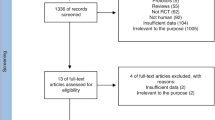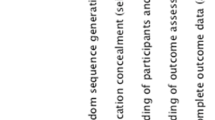Abstract
Aim
To systematically evaluate the cariogenic potential of various commercially available infant formulas.
Materials and methods
A literature search was conducted using Pubmed and Scopus databases for articles published between 1966 and November 2014. Reference lists of all eligible studies were searched. Only human studies were included. Data extraction and risk of bias assessments were performed.
Results
Seven of the 83 articles identified were included in this review, of which six studies employed plaque harvesting methods, while one study utilised an intra-oral cariogenicity/in situ model. Three studies compared milk-based formulas (MBFs) and soy-based formulas (SBFs), two compared protein hydrolysate formulas (PHFs) with MBFs and SBFs, four compared formulas with various types of sugar, and two studies compared formulas with varying casein content. Based on a single study, SBFs were significantly more cariogenic than MBFs. Formulas containing only non-milk extrinsic sugars (NMES) and those containing lactose + NMES were found to be significantly more cariogenic than formulas containing only lactose. No significant correlation was found between cariogenicity and casein content in infant formula. The results of studies comparing PHFs with MBFs and SBFs were contradictory. Risk of bias assessment revealed that five studies were at moderate risk of bias, and two were assessed to be at high risk of bias.
Conclusion
The result for cariogenicity of various types of infant formulas remains inconclusive, thus no concrete recommendations can be made. Further well-designed studies are needed to clarify the effect of casein content on cariogenicity.

Similar content being viewed by others
References
Al-Ahmari Z, Adenubi JO. Evaluation of acidogenic potential of infant milk formula. Saud Dent J. 2003;15:88–95.
American Academy of Pediatrics. Committee on nutrition: hypoallergenic infant formulas. Pediatrics. 2000;106:346–9.
American Dental Association Health Foundation Research Institute. Scientific consensus conference on methods for assessment of the cariogenic potential of food. J Am Dent Assoc. 1986;535.
Bhatia J, Greer F, American Academy of Pediatrics Committee on Nutrition. Use of soy protein-based formulas in infant feeding. Pediatrics. 2008;121:1062–8.
Bowen WH, Pearson SK, Rosalen PL, et al. Assessing the cariogenic potential of some infant formulas, milk and sugar solutions. J Am Dent Assoc. 1997;128:865–71.
Brown CR, Dodds L, Legge A, et al. Factors influencing the reasons why mothers stop breastfeeding. Can J Publ Health. 2014;105:e179–85.
Chaudhary SD, Chaudhary M, Singh A, Kunte S. An assessment of the cariogenicity of commonly used infant milk formulae using microbiological and biochemical methods. Int J Dent. 2011;2011:320798.
Curzon ME, Hefferren JJ. Modern methods for assessing the cariogenic and erosive potential of foods. Br Dent J. 2001;191:41–6.
Danchaivijitr A, Nakornchai S, Thaweeboon B, et al. The effect of different milk formulas on dental plaque pH. Int J Paediatr Dent. 2006;16:192–8.
De Mazer Papa AM, Tabchoury CP, Del Bel Cury AA, et al. Effect of milk and soy-based infant formulas on in situ demineralization of human primary enamel. Pediatr Dent. 2010;32:35–40.
Denne SC. Neonatal nutrition. Pediatr Clin N Am. 2015;62:427–38.
Do LG, Levy SM, Spencer AJ. Association between infant formula feeding and dental fluorosis and caries in Australian children. J Publ Health Dent. 2012;72:112–21.
Erickson PR, Mcclintock KL, Green N, Lafleur J. Estimation of the caries-related risk associated with infant formulas. Pediatr Dent. 1998;20:395–403.
Moynihan PJ, Wright WG, Walton AG. A comparison of the relative acidogenic potential of infant milk and soya infant formula: a plaque pH study. Int J Paediatr Dent. 1996;6:177–81.
Munshi AK, Kavitha H, Shanthi KP. Acidogenic potential of the infant formulas marketed in India. J Indian Soc Pedod Prev Dent. 2001;19:1–9.
Ozer S, Tunc ES. The effect of common infant foods on plaque pH. Oral Health Prev Dent. 2012;10:123–8.
Peres RC, Coppi LC, Franco EM, et al. Cariogenicity of different types of milk: an experimental study using animal model. Braz Dent J. 2002;13:27–32.
Peres RC, Coppi LC, Volpato MC, et al. Cariogenic potential of cows’, human and infant formula milks and effect of fluoride supplementation. Br J Nutr. 2009;101:376–82.
Raju AS, Hirehal M, Manjunath PG, et al. The acidogenic potential of different milk formulas on dental plaque pH. Oral Health Prev Dent. 2012;10:225–30.
Reynolds EC, Del Rio A. Effect of casein and whey-protein solutions on caries experience and feeding patterns of the rat. Arch Oral Biol. 1984;29:927–33.
Sheikh C, Erickson PR. Evaluation of plaque pH changes following oral rinse with eight infant formulas. Pediatr Dent. 1996;18:200–4.
Somerfield M, Padberg J, Pfister D, et al. ASCO clinical practice guidelines: process, progress, pitfalls, and prospects. Class Pap curr comments. 2000, pp 881–886.
Stookey GK. Reactor paper concerning patient selection and appliance design in intra-oral models. J Dent Res. 1992;71:911–2.
Sung YH, Kim HY, Son HH, Chang J. How to design in situ studies: an evaluation of experimental protocols. Restor Dent Endod. 2014;39:164–71.
Tahmassebi JF, Duggal MS. Comparison of the plaque pH response to an acidogenic challenge in children and adults. Caries Res. 1996;30:342–6.
ten Cate JM. Models and role models. Caries Res. 2015;49(Suppl 1):3–10.
Tinanoff N, O'Sullivan DM. Early childhood caries: overview and recent findings. Pediatr Dent. 1997;19(1):12–6.
Author information
Authors and Affiliations
Corresponding author
Rights and permissions
About this article
Cite this article
Tan, S.F., Tong, H.J., Lin, X.Y. et al. The cariogenicity of commercial infant formulas: a systematic review. Eur Arch Paediatr Dent 17, 145–156 (2016). https://doi.org/10.1007/s40368-016-0228-x
Received:
Accepted:
Published:
Issue Date:
DOI: https://doi.org/10.1007/s40368-016-0228-x




